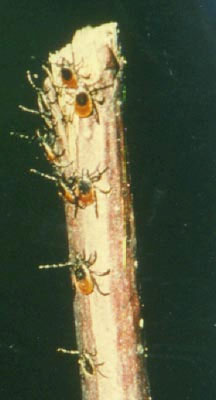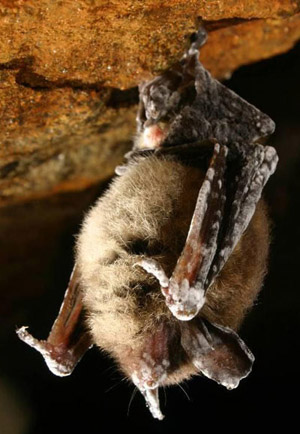- Home
- About S&T
- Taxa/Organisms
- Ecosystems
- Issues
- Methods & Tools
- Reports & Publications
- Location
- Search
Publisher: USGS | Science Center: Leetown Science Center (LSC, Kearneysville) | Format: URL
www.lsc.usgs.gov — This is a research project whose primary objective is to assess the health of selected fish species (brown bullhead and largemouth bass) and compare these findings with historic information on fish health in the individual rivers and with concurrent samples collected at reference sites. A secondary objective is to compare and correlate the fish More...

Publisher: USGS | Science Center: Patuxent Wildlife Research Center (PWRC, Laurel) | Format: URL
www.pwrc.usgs.gov — Dr. Howard Ginsberg is studying the transmission of Lyme disease spirochetes in nature using ecological studies of ticks and their vertebrate hosts, and models of spirochete transmission dynamics. Environmental factors that influence tick populations apparently operate on a regional scale. Distribution of vertebrate hosts plays a role in tick More...

2007 | Publisher: Other (Ecological Society of America) | Format: .PDF
www.nrmsc.usgs.gov — Every winter, government agencies feed ;6000 metric tons (63 106 kg) of hay to elk in the southern Greater Yellowstone Ecosystem (GYE) to limit transmission of Brucella abortus, the causative agent of brucellosis, from elk to cattle. Supplemental feeding, however, is likely to increase the transmission of brucellosis in elk, and may be affected by More...

June 2001 | Publisher: USGS | Science Center: Western Ecological Research Center (WERC, Sacramento) | Format: URL
www.werc.usgs.gov — Salvage of injured, recently dead, ill, and dying desert tortoises is a very important part of recovery programs for these reptiles. Salvaged desert tortoises can provide a wealth of information about such subjects as health, disease, presence of heavy metals and other toxicants, and causes of mortality in populations. When tortoises are salvaged More...

Publisher: USGS | Science Center: Fort Collins Science Center (FORT, Ft. Collins) | Format: URL
www.fort.usgs.gov — The dynamics of rabies transmission in bat populations that roost and live within cities is being investigated using Fort Collins, Colo., and big brown bats (Eptesicus fuscus) as the case study. USGS biologists are working on this project in collaboration with Colorado State University, the Centers for Disease Control and Prevention, and the More...

Publisher: USGS | Format: URL
www.usgs.gov — It has been estimated that over 100,000 bats have died in the northeast due to a mysterious white fungus called White-Nose Syndrome (WNS). Scientists are finding within caves and mines a large number of bats with a white fungus on their muzzles and other parts of their bodies. It is uncertain as to how this fungus is being transmitted and its More...

Publisher: Other Federal Agency (United States Fish and Wildlife Service (USFWS)) | Format: URL
www.fws.gov — Tens of thousands of hibernating bats died this winter in the northeast, and for unknown reasons. In and around caves and mines in eastern and upstate New York, Vermont, western Massachusetts, and northwestern Connecticut, biologists found sick, dying and dead bats in unprecedented numbers. In just eight of the affected New York caves, mortality More...

Publisher: USGS | Science Center: Columbia Environmental Research Center (CERC, Columbia) | Format: .PDF
www.cerc.usgs.gov — The study described in this report was conducted as part of the USGS Biomonitoring of Environmental Status and Trends (BEST) Program. This project collected, examined, and analyzed 217 fish representing three species at 10 stations in the US portion of the Yukon River Basin (YRB) from May to October 2002. Four sampling sites were located on the More...

Publisher: USGS | Science Center: Western Fisheries Research Center (WFRC, Seattle) | Format: URL
wfrc.usgs.gov — Anadromous salmonids are susceptible to a variety of pathogenic microorganisms, including at least 30 bacteria and viruses. Whereas the impact of these microorganisms on salmonids in wild and natural rearing areas is difficult to measure, losses from disease among hatchery salmonids are both common and well documented. The immunology laboratory More...

Publisher: USGS (Coastal and Marine Geology Program, Eastern Region) | Format: URL
coastal.er.usgs.gov — Coral microbial ecology is the study of the relationship of coral-associated microorganisms to each other, the coral host, and to their environment. Just as we humans have beneficial bacteria living on our skin and in our intestines, corals also have co-habitating non-pathogenic (not disease-causing) microbes. These microbes include bacteria, More...

Publisher: USGS | Science Center: Western Fisheries Research Center (WFRC, Seattle) | Format: URL
wfrc.usgs.gov — Viral infections are common causes of disease outbreaks and mortalities in both wild and captive fish populations. Due to the long history of virus outbreaks there is a substantial body of knowledge about viruses within the field of fish pathology. This project involves research and development studies which create, modify and apply modern More...

Publisher: USGS | Science Center: Fort Collins Science Center (FORT, Ft. Collins) | Format: URL
www.fort.usgs.gov — During the winter of 2006 or 2007, an affliction of unknown origin dubbed "White-Nose Syndrome" (WNS) began devastating colonies of hibernating bats in a small area around Albany, New York. Colonies of hibernating bats were reduced 81-97 percent at the affected caves and mines that were surveyed. Since then, White-Nose Syndrome has been detected More...
